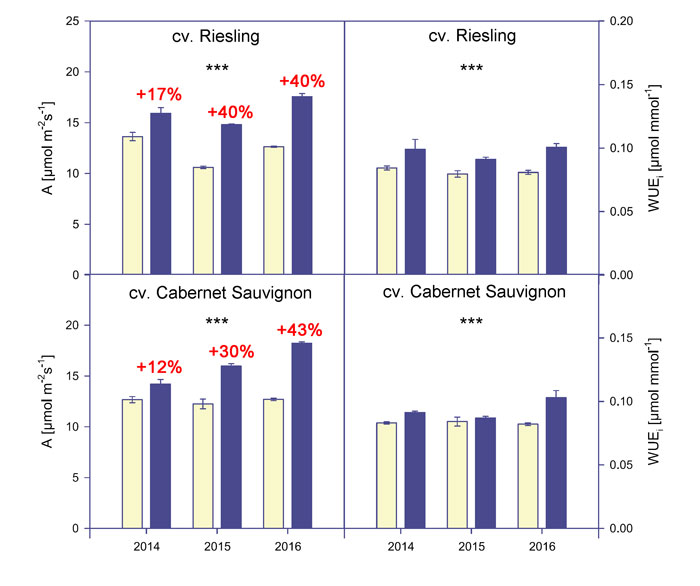| Tweet | Follow @co2science |
Paper Reviewed
Wohlfahrt, Y., Smith, J.P., Tittmann, S., Honermeier, B. and Stoll, M. 2018. Primary productivity and physiological responses of Vitis Vinifera L. cvs. Under Free Air Carbon dioxide Enrichment (FACE). European Journal of Agronomy 101: 149-162.
Viticulture is a key industry in many parts of the world and many studies have investigated the potential impacts of climate change on grapevine physiology and yield in the past few decades. One such study that we have not yet examined on CO2 Science is that of Wohlfahrt et al. (2018), who utilized FACE technology to examine the growth response of two key cultivars to a small (79 ppm) increase in atmospheric CO2 concentration over three consecutive growing seasons (2014-2016).
The plants were grown in the field at the VineyardFACE experimental site at Hochschule Geisenheim University in the Rheingau wine region of Germany. CO2 fumigation in the elevated CO2 treatments was applied during daylight hours only for all days of the year. According to the authors, Riesling was selected "as a representative of a white cool climate cultivar having a long tradition of cultivation in Germany," whereas the second cultivar, Cabernet Sauvignon, was selected "as a warmer climate cultivar and one of the most renowned and widely grown red grape varieties in the world." Over the course of the three year study, a number of physiological and growth-related measurements were collected to determine the impacts of elevated CO2.
In describing their findings, Wohlfahrt et al. report that "the elevated CO2 treatment led to significantly higher net assimilation as well as intrinsic water use efficiency, evaporation and stomatal conductance for both cultivars." As shown in Figure 1, for example, net photosynthesis increased by 17%, 40% and 40% for Riesling and by 12%, 30% and 43% for Cabernet Sauvignon in 2014, 2015, and 2016, respectively. Such growth enhancement, coupled with a decline in stomatal conductance, led to an average 10% and 21% increase in intrinsic water use efficiency for Cabernet Sauvignon and Riesling cultivars, respectively, over the three-year study period.
Wohlfahrt et al. also report that the sugar concentration of must at harvest were not affected by elevated CO2 for either grape variety. And, with respect to yield, the authors note that elevated CO2 "resulted in higher total yield and clean fruit yield" (clean fruit yield represents the total yield minus fruit infected with bunch rot caused by Botrytis cinerea). In this regard, clean fruit yield was enhanced by a three-year average of 7.5% for Riesling and 11.2% for Cabernet Sauvignon. Furthermore, they note that "neither incidence nor frequency of B. cinerea was altered under elevated CO2 for both cultivars."
In light of all the above, it is quite remarkable that a small (79 ppm) increase in atmospheric CO2 is capable of providing such significant growth and yield-related benefits to the viticulture industry.

Figure 1. Net photosynthesis (A) and intrinsic water use efficiency (WUEi) of Vitis vinifera cultivars Riesling and Cabernet Sauvignon grown under ambient (yellow shaded bars) and elevated (blue shaded bars) CO2 for three growing seasons. Means and standard errors are shown and *** indicates statistical significance (p < 0.001) of main factor treatment over three years. Source: Wohlfahrt et al. (2018).




